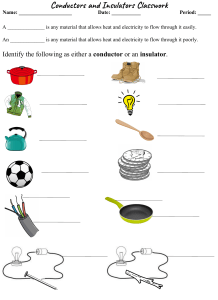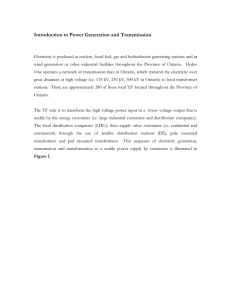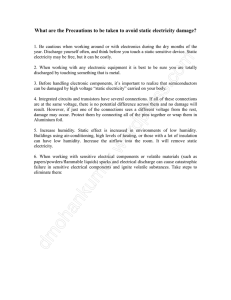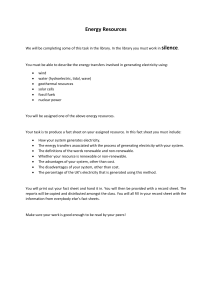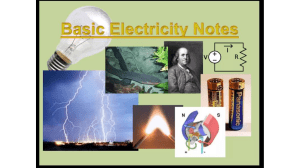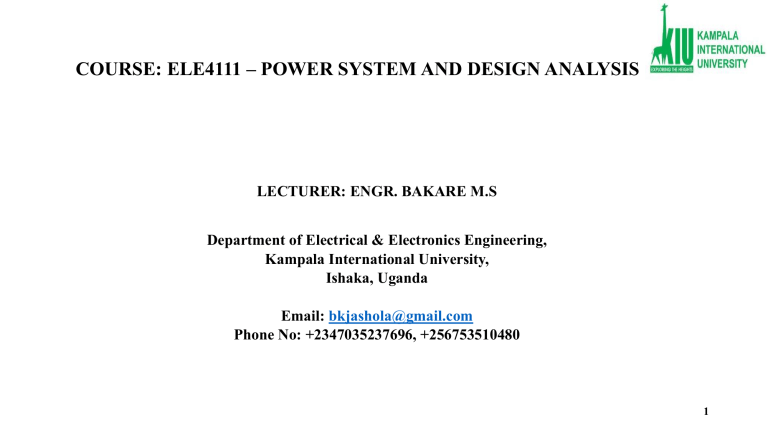
COURSE: ELE4111 – POWER SYSTEM AND DESIGN ANALYSIS LECTURER: ENGR. BAKARE M.S Department of Electrical & Electronics Engineering, Kampala International University, Ishaka, Uganda Email: bkjashola@gmail.com Phone No: +2347035237696, +256753510480 1 INDEX 1. POWER GENERATION, TRANSMISSION AND DISTRIBUTION 2. POWER SYSTEM NETWORK MATRICES 3. POWER FLOW STUDIES 1 4. POWER FLOW STUDIES 2 5. SHORT CIRCUIT ANALYSIS – I 6. SHORT CIRCUIT ANALYSIS – 2 7. STABILITY ANALYSIS 2 POWER SYSTEM STRUCTURE • A power system is a network which comprises components that produce electrical energy and transmit this energy to consumers. • A modern electric power system has mainly six main components: 1) power plants which generate electric power, 2) transformers which raise or lower the voltages as needed, 3) transmission lines to carry power, 4) substations at which the voltage is stepped down for carrying power over the distribution lines, 5) distribution lines, and 6) distribution transformers which lower the voltage to the level needed for the consumer equipment. • A typical power system structure is shown in Fig. 1. • The production and transmission of electricity is relatively efficient and inexpensive, although unlike other forms of energy, electricity is not easily stored, and thus, must be produced based on the demand. 3 POWER SYSTEM STRUCTURE 4 POWER GENERATION • Actually, in power generation, one form of energy gets converted into electrical energy. • We produce electrical energy from various natural sources. We classify these sources into two types renewable sources and non-renewable sources. • In a present power system, most of the electrical energy gets generated from non-renewable sources like coal, oil, and natural gases. • But these sources are limitedly available. So, we have to use these sources carefully and always find an alternate source or move on to renewable sources. • The renewable sources include solar, wind, water, tidal, and biomass. These sources are the environment-friendly, free and infinite resources available. 5 POWER GENERATION 6 NEED OF VOLTAGE TRANSFORMATION • Under ideal conditions the voltage and current change by the same factor for any transformer, which explains why the primary power value is equal to the secondary power value • As one value decreases the other increases to keep at a constant equilibrium power level. • Transformers can be extremely efficient. High-power transformers can reach the 99% mark of efficiency, as a result of successes in minimizing transformer losses. However, a transformer will always output a slightly lower power than its input, as losses cannot be eliminated completely. • 1. 2. 3. Keeping this in mind, power is transmitted at high voltage for the following reasons. To reduce power losses. To reduce power transmission cost. To improve the efficiency of power transmission 7 SIGNIFICANCE OF STANDARD FREQUENCY USED IN A.C • Standard frequency of AC system plays vital role. For Uganda, Standard frequency is 50Hz ± 1%. It must be kept constant within ±1% because: 1. It produces constant speed of induction motor & output torque remains constant. Ns = 120f P; Ns = synchronous speed, f= frequency, P = No. of poles 1. If frequency is decreased or increased it affects the production behavior of industries. 2. If frequency of alternator is increased the voltage increases which may damage electrical equipment. 3. Damage in insulation might take place and decrease the life of electrical equipments, filaments and lamps. 4. From transformer equation, E = 4.44 x ϕm x f x N. If frequency increases induced voltage(emf) will increase. If frequency decreases voltage will decrease. Thus, it must be kept constant within ±1%. 8 IMPORTANCE OF ELECTRICAL POWER IN DAY TODAY LIFE. • Electricity is one of the most important blessings that science has given to mankind. It has also become a part of modern life and one cannot think of a world without it. Electricity has many uses in our day to day life. • It is used for lighting rooms, working fans and domestic appliances like using electric stoves, A/C and more. All these provide comfort to people. • In factories, large machines are worked with the help of electricity. Essential items like food, cloth, paper and many other things are the product of electricity. • Modern means of transportation and communication have been revolutionized by it. Electric trains and battery cars are quick means of travel. • Electricity also provides means of amusement, radio, television and cinema, which are the most popular forms of entertainment are the result of electricity. • Modern equipment like computers and robots have also been developed because of electricity. • Electricity plays a pivotal role in the fields of medicines and surgery too — such as X-ray, ECG. The use of electricity is increasing day by day. 9
